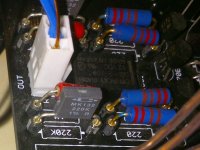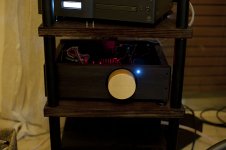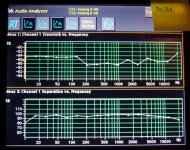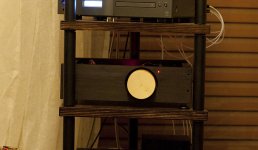are the 220K ones quality sensitive as well? If I remember correctly they are not in series with signal.
IMHO, yes.
So far my best bet is for Caddock MK132
Attachments
When going for an all out and specific system synergistic DCB1 high hopes & high hot rod, there are a number of things that can be tuned. But first, a check with correctly terminated gen and scope must be run when the buffer is fed and driving thru its installation interconnects to examine that square waves are smooth. If not, the input or output 220R may need go more in value. If good, they may be attempted to go lower until oscillation breaks through, then back and up a bit. That will give it the lowest output impedance in a given system and more kicking sound.
Then subjectives may come in, like R-Core VS Toroid VS EI, signal series and shunt resistor types, pot type and timbre synergy, vref and terminal filter caps, main filter caps.
Then subjectives may come in, like R-Core VS Toroid VS EI, signal series and shunt resistor types, pot type and timbre synergy, vref and terminal filter caps, main filter caps.
The harshness described above, is by no means a sense of distortion. It s more like super clarity in mids and highs that sounds too much because the mid-lows are a bit shy and do not sweeten things as much as I would liked. Voices and mids sound really spooky real though 
To be honest the buffer has already exceeded my expectations and I really have to draw a line somewhere and start enjoying some music Not to mention the rest of the projects waiting in line...
Not to mention the rest of the projects waiting in line... 
In a week or two if things have not settled as I would have wanted them, I may consider changing the caps with the new Panasonic FRs that I really like and which give nice and strong low. And maybe some Z-Foils on the 220 position or a better pot.
For now I will just replace the super-bright and super-annoying white led with a normal red one. And then sit back and relax with some Pink Floyd
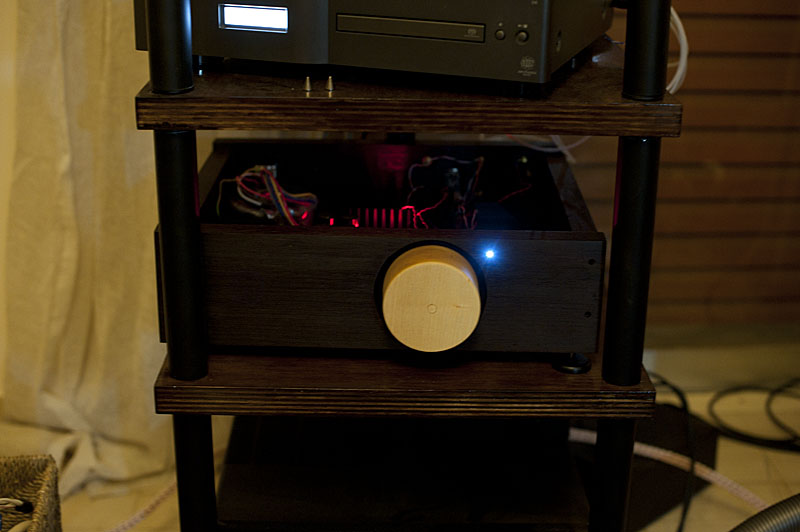
To be honest the buffer has already exceeded my expectations and I really have to draw a line somewhere and start enjoying some music
In a week or two if things have not settled as I would have wanted them, I may consider changing the caps with the new Panasonic FRs that I really like and which give nice and strong low. And maybe some Z-Foils on the 220 position or a better pot.
For now I will just replace the super-bright and super-annoying white led with a normal red one. And then sit back and relax with some Pink Floyd
Attachments
By the way a few notes for the "full out" build (mine is far from that ).
A hot rod build has a really hot Rset so it might be a good idea to solder the resistors on the bottom if they do not need heatsinks to keep the heat a away from the filter caps. Or attach them to the bottom plate if you use one. It would also be a nice idea to keep the filter caps and diodes in a separate board somewhere a bit further away or in a completely separate case with the transformer.
This might also be a nice idea for future revisions of the boards, to allow scoring of the filter/diode part.
Something else that really frustrates me is how close to each other are the in and out R, L and GND pads to each other. I understand that it is a convenient layout to allow the use of molex terminals. But it is a really tricky area that might induce some crosstalk or worse. Especially if the joints are not clean.
This brings me to another issue, which is the use of the cheap molex terminals in the signal. I mean we spend hundreds of dollars or euros for boutique, low noise, high clarity parts, good quality rca ports and plugs and such stuff, and then go and stick those awful cheapass molex terminals right in the signal path... Such a convenience thingy really has no place in an "all out" build. Not even in test builds where critical listening is done for A/B testing between critical parts.
Final note, further to the above point, I really think an all out build should be a full dual mono one (full psu with only one channel in the buffer built)
There
A hot rod build has a really hot Rset so it might be a good idea to solder the resistors on the bottom if they do not need heatsinks to keep the heat a away from the filter caps. Or attach them to the bottom plate if you use one. It would also be a nice idea to keep the filter caps and diodes in a separate board somewhere a bit further away or in a completely separate case with the transformer.
This might also be a nice idea for future revisions of the boards, to allow scoring of the filter/diode part.
Something else that really frustrates me is how close to each other are the in and out R, L and GND pads to each other. I understand that it is a convenient layout to allow the use of molex terminals. But it is a really tricky area that might induce some crosstalk or worse. Especially if the joints are not clean.
This brings me to another issue, which is the use of the cheap molex terminals in the signal. I mean we spend hundreds of dollars or euros for boutique, low noise, high clarity parts, good quality rca ports and plugs and such stuff, and then go and stick those awful cheapass molex terminals right in the signal path... Such a convenience thingy really has no place in an "all out" build. Not even in test builds where critical listening is done for A/B testing between critical parts.
Final note, further to the above point, I really think an all out build should be a full dual mono one (full psu with only one channel in the buffer built)
There
This is the cross talk from Mezmerize with six input relays and an Alps 27. Its possibly better in the Hypnotize by having drastically less input vias.
You can solder wires directly to pads, Molex aren't obligatory.
Such double mono boards would be few to warrant a feasible GB maybe...Maybe.
You can solder wires directly to pads, Molex aren't obligatory.
Such double mono boards would be few to warrant a feasible GB maybe...Maybe.
Attachments
You can solder wires directly to pads, Molex aren't obligatory.
I know that's what I did. Just mentioning it because I saw them in almost every build in the thread.
Such double mono boards would be few to warrant a feasible GB maybe...Maybe.
I don t think we need different boards for dual mono. We would just populate 1 channel in the buffer section for a single channel.
Well whether you believe it or not, removing the super bright white led and replacing it with a normal red one fixed the harshness....[/IMG]
Interesting! Well, I'm not surprised at all. Who knows what the mechanisms are, but I've observed all sorts of things making a difference in the final sound.
Well, I have to admit that I'm a Johnny-come-lately to this thread. I've been out of DIY for several years and have recently put my toe back in.
I started reading the beginning of the discussion; it is quite long and technical, so I am slowly catching up. Please be patient with me.
One question that comes to mind is: in the final analysis, how does hotrodding benefit the sound? I got to the part that says that Mr. Pass ran his B1 near the specified current limit of the devices, but not over. Does bumping them higher result in improved sound quality?
Also, I see that there are several configurations that can be set up. One is a unity gain buffer. That is what I plan on using mine for.
In the case of a buffer, does hotrodding apply, or is that for some other configuration? Do some of these configurations offer gain, to turn the circuit into a preamp instead of a buffer?
Again, I'm just catching up so I'm sure these answers are in the thread. But if someone could offer some insights it would be most appreciated!
Last edited:
Well B1 and DCB1 are buffers, so unity gain either way. Hotrod or not.
About the Hotroding part, as it is used in this thread it refers to the current passed from the Salas shunt PSU and not the biasing of the buffer jfets.
Hotroding benefits from my experience are similar to the effects that bigger transformers have. In general terms imagine it supplying more current so that circuit can work with less limitations. A good analogy I like mentioning to help understand this better is the difference between the words "enough" and "plenty".
Generally speaking you should initially expect a boost in the "power" and clarity of sound and as you increase it further you start getting more separation and better imaging. Of course diminishing returns come at play fast and it all is a matter of general synergy with the rest of your system, so your experience might vary.
Definitely worth the effort.
About the Hotroding part, as it is used in this thread it refers to the current passed from the Salas shunt PSU and not the biasing of the buffer jfets.
Hotroding benefits from my experience are similar to the effects that bigger transformers have. In general terms imagine it supplying more current so that circuit can work with less limitations. A good analogy I like mentioning to help understand this better is the difference between the words "enough" and "plenty".
Generally speaking you should initially expect a boost in the "power" and clarity of sound and as you increase it further you start getting more separation and better imaging. Of course diminishing returns come at play fast and it all is a matter of general synergy with the rest of your system, so your experience might vary.
Definitely worth the effort.
Last edited:
it is quite long and technical, so I am slowly catching up. Please be patient with me.
Also, I see that there are several configurations that can be set up. One is a unity gain buffer. That is what I plan on using mine for.
But if someone could offer some insights it would be most appreciated!
Just because ive got an nearly stuffed Mezmerize in my projectsbox and i plan to mate it to paradise phono.
Is there or will there be somewhere a guide with the dos and donts for one dummy to build it properly ?
The thread that helped me a lot is this
DC-Coupled B1 Buffer Build
And of course check the pdfs in Tea-Bag's blog entry
DC-Coupled B1 Buffer Build
And of course check the pdfs in Tea-Bag's blog entry
Well B1 and DCB1 are buffers, so unity gain either way. Hotrod or not.
About the Hotroding part, as it is used in this thread it refers to the current passed from the Salas shunt PSU and not the biasing of the buffer jfets.
Hotroding benefits from my experience are similar to the effects that bigger transformers have... Definitely worth the effort.
Hot rod does not change the amplifier, the B1 part.
Hot rod refers to the shunt regulator part.
Thanks, guys. This really explains a lot. I'm very eager to hear more about everyone's builds as they burn in. Very cool!
My project was going well for a few months and then stopped working. All LEDs appear to be on. I checked input voltage and it was about 350mv on the inputs. On the outputs I get about 35mv. Where is a good place to start looking as to the cause?
Thanks
Swapped the relay, still the same problem, any ideas?
Thanks
My project was delayed (again), the faceplate had to be left at the powdercoaters due to a scratch on the face, it was just laying around....so it got damaged. Once it's back in my hands then it's off to the engravers for details and scripting. I'll post pictures when it get back from there.
Ron
Ron
So I've been using Tupperware-type containers as low cost, easy to work cases for low voltage/low heat circuits like DACs, Class D amps, and autoformer volume controls. Some of the nicer food containers, like the red and white ones from Ikea, actually make very handome cases, if somewhat tongue-in-cheek ones.
So I'm thinking for my first build of Tea Bag's red, white, and black kit from the GB, I'm going to build it with the specified components. This is simply so I actually get it built rather than scheming to collect all the parts for a hot rod build and then never getting around to it. I also want to see what the stock design has to offer before going hot rod.
Will the stock circuit run cool enough that I could put it in one of those food containers safely? They do get pretty hot in the microwave when reheating food, though that's a wet heat. If so, I do realize that I'd have to move it to another case for a hot rod build.
So I'm thinking for my first build of Tea Bag's red, white, and black kit from the GB, I'm going to build it with the specified components. This is simply so I actually get it built rather than scheming to collect all the parts for a hot rod build and then never getting around to it. I also want to see what the stock design has to offer before going hot rod.
Will the stock circuit run cool enough that I could put it in one of those food containers safely? They do get pretty hot in the microwave when reheating food, though that's a wet heat. If so, I do realize that I'd have to move it to another case for a hot rod build.
A standard DCB1 has a current through the CCS of ~60mA.
The transformer is recommended as 15Vac+15Vac, 30 to 50VA.
That gives a total dissipation of ~44Vdc*0.06Adc + transformer losses = 2.6W + 2W = <5W
If you hot rod then that dissipation can increase ten fold.
That heat, whether standard or hot rod, has to get out of the enclosure !
The transformer is recommended as 15Vac+15Vac, 30 to 50VA.
That gives a total dissipation of ~44Vdc*0.06Adc + transformer losses = 2.6W + 2W = <5W
If you hot rod then that dissipation can increase ten fold.
That heat, whether standard or hot rod, has to get out of the enclosure !
- Home
- Source & Line
- Analog Line Level
- Salas hotrodded blue DCB1 build
